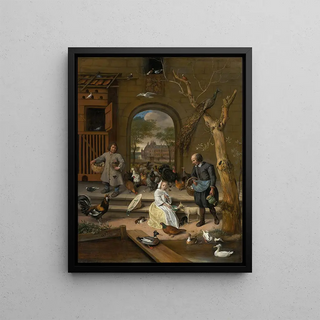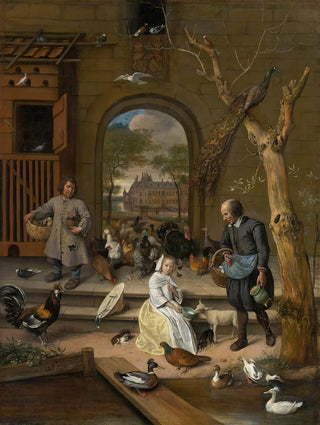Art print | Portrait of Jacoba Maria van Wassenaer 1654-1683, known as La Basse-cour - Jan Steen


View from behind

Frame (optional)
Portrait of Jacoba Maria van Wassenaer 1654-1683, known as La Basse-cour - Jan Steen – Captivating Introduction
In the vibrant world of 17th-century art, the art print "Portrait of Jacoba Maria van Wassenaer 1654-1683, known as La Basse-cour" by Jan Steen stands out as an iconic work. This portrait, which transcends mere representation, invites the viewer to delve into the intimate and warm universe of its subject. The scene depicts not only the figure of Jacoba Maria but also a moment of everyday life, where harmony between man and nature seems to be celebrated. Through this piece, the artist succeeds in capturing an essence of Dutch life while offering a reflection on the fleeting beauty of existence.
Style and uniqueness of the work
The uniqueness of this art print lies in how Jan Steen blends realism with a touch of poetry. The baroque style, characterized by dramatic lighting and striking contrasts, is omnipresent. The color palette, rich and vibrant, helps create a lively and engaging atmosphere. Every detail, from Jacoba's gaze to the bucolic background, is carefully thought out to evoke a sense of warmth and closeness. Steen, a master of visual storytelling, manages to transform a simple portrait into a scene of life, where everyday elements intertwine with the depiction of the subject. This approach gives the work an almost narrative dimension, where each look at the art print reveals new stories to explore.
The artist and his influence
Jan Steen, an emblematic figure of the Dutch Golden Age, is recognized not only for his portraits but also for his genre scenes depicting the daily life of his contemporaries. His artistic approach, imbued with realism and humanity, influenced many artists of his time and subsequent generations. Steen does not merely paint faces; he captures emotions, interactions, and stories. His work is a mirror of 17th-century Dutch society, where pleasure, conviviality, and morality coexist. By incorporating elements of everyday life into his compositions, he

Matte finish

View from behind

Frame (optional)
Portrait of Jacoba Maria van Wassenaer 1654-1683, known as La Basse-cour - Jan Steen – Captivating Introduction
In the vibrant world of 17th-century art, the art print "Portrait of Jacoba Maria van Wassenaer 1654-1683, known as La Basse-cour" by Jan Steen stands out as an iconic work. This portrait, which transcends mere representation, invites the viewer to delve into the intimate and warm universe of its subject. The scene depicts not only the figure of Jacoba Maria but also a moment of everyday life, where harmony between man and nature seems to be celebrated. Through this piece, the artist succeeds in capturing an essence of Dutch life while offering a reflection on the fleeting beauty of existence.
Style and uniqueness of the work
The uniqueness of this art print lies in how Jan Steen blends realism with a touch of poetry. The baroque style, characterized by dramatic lighting and striking contrasts, is omnipresent. The color palette, rich and vibrant, helps create a lively and engaging atmosphere. Every detail, from Jacoba's gaze to the bucolic background, is carefully thought out to evoke a sense of warmth and closeness. Steen, a master of visual storytelling, manages to transform a simple portrait into a scene of life, where everyday elements intertwine with the depiction of the subject. This approach gives the work an almost narrative dimension, where each look at the art print reveals new stories to explore.
The artist and his influence
Jan Steen, an emblematic figure of the Dutch Golden Age, is recognized not only for his portraits but also for his genre scenes depicting the daily life of his contemporaries. His artistic approach, imbued with realism and humanity, influenced many artists of his time and subsequent generations. Steen does not merely paint faces; he captures emotions, interactions, and stories. His work is a mirror of 17th-century Dutch society, where pleasure, conviviality, and morality coexist. By incorporating elements of everyday life into his compositions, he






